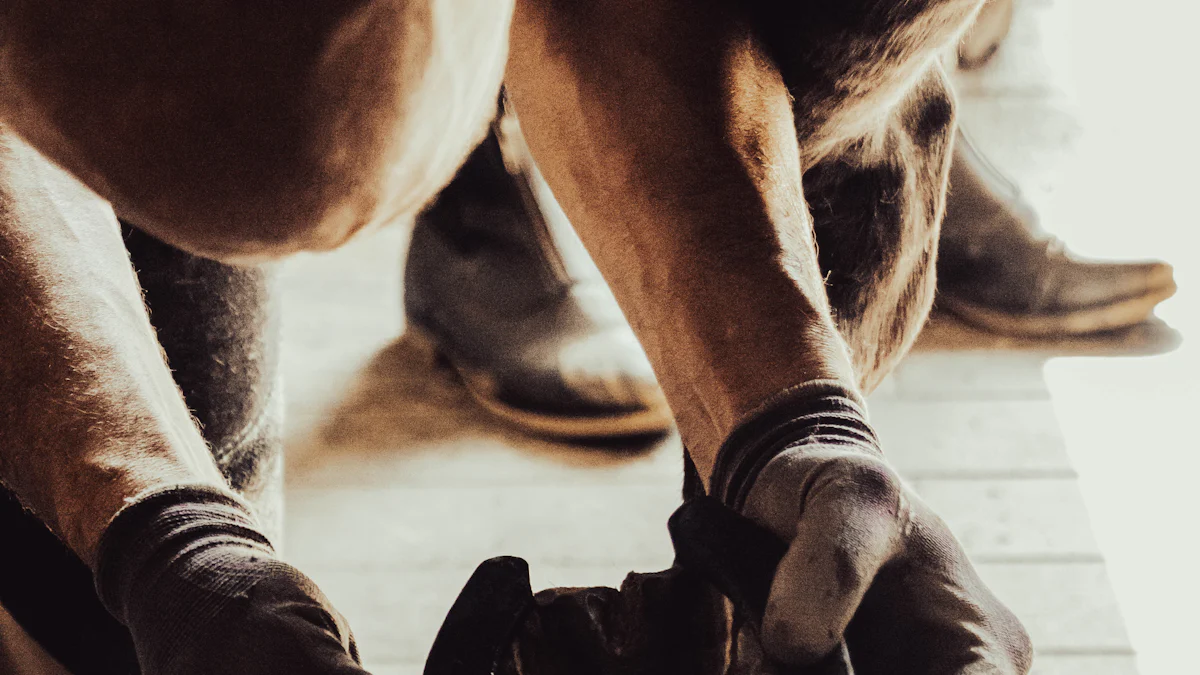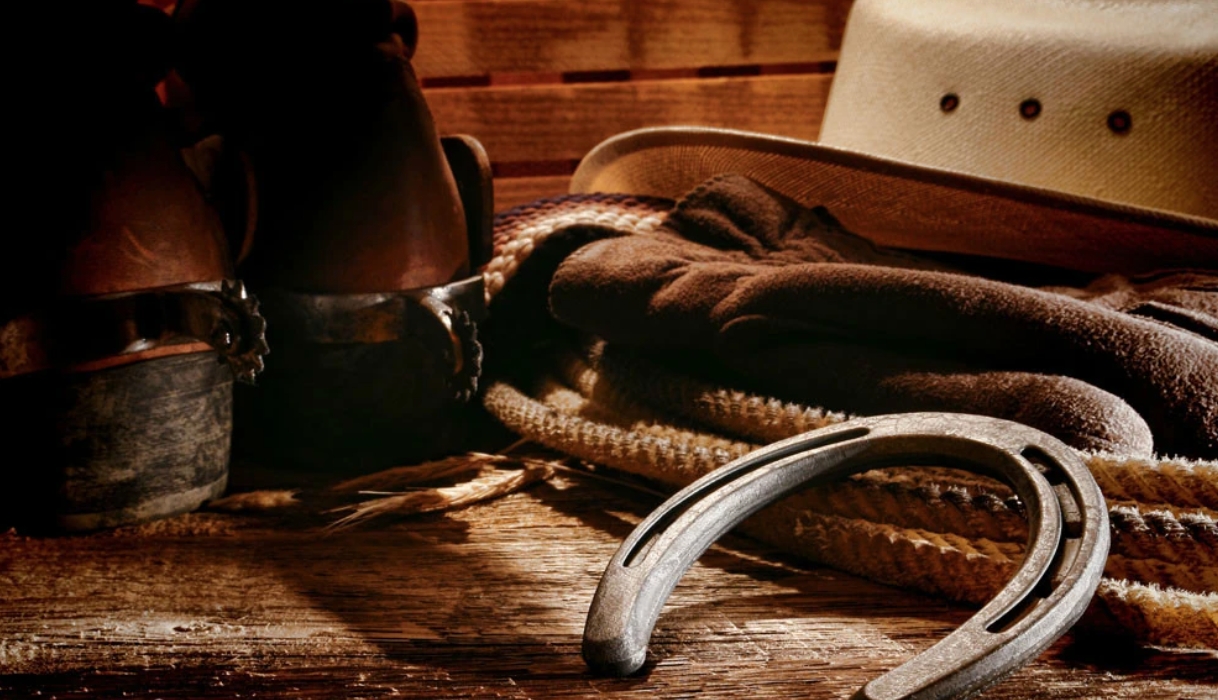- 0
- 0
- English
- 简体中文
- Deutsch
- Español
- Français
- Italiano
- 日本語
- 한국어
- Nederlands
- Português
- Русский
- Tiếng Việt
- العربية
5 Benefits of Using Horseshoes for Your Horse
If you own a horse, you know how important it is to keep their hooves healthy and strong. A horseshoe can make all the difference in protecting those hooves from daily wear and tear. Whether your horse is competing in equestrian events or simply walking on hard surfaces, horseshoes improve traction and prevent excessive hoof damage. They also offer therapeutic benefits, helping horses recover from injuries or manage hoof conditions. By using horseshoes, you’re giving your horse the support they need to stay comfortable and perform their best.
Key Takeaways
-
Horseshoes keep your horse's hooves safe from hard surfaces. This helps them last longer and avoids painful problems.
-
Horseshoes give better grip, helping your horse stay steady on slippery ground. This makes them more confident and perform better in activities.
-
Horseshoes fix hoof problems and walking issues. They help your horse move better and avoid future health troubles.
-
Special horseshoes help heal injuries and make weak hooves stronger. This lets your horse feel better and move easily again.
-
The right horseshoes improve how your horse works or competes. They help your horse do their best in any task.
1. Protects Hooves from Wear and Tear

Prevents Damage on Hard Surfaces
Your horse’s hooves are tough, but they’re not invincible. Without proper protection, hard surfaces like concrete, gravel, or rocky trails can cause significant damage over time. Domesticated horses often face unnatural wear patterns because they don’t move as consistently as wild horses. While wild horses travel at a steady pace, your horse might alternate between periods of activity and rest. This inconsistency can lead to uneven hoof wear.
Environmental factors also play a big role. Moisture and temperature changes can soften the keratin in your horse’s hooves, making them more vulnerable to cracks and chips. Imagine walking barefoot on rough terrain—your feet would feel every sharp edge and hard surface. Similarly, without a horseshoe, the hard outer layer of your horse’s hoof can thin out, exposing the sensitive inner tissue. This can make walking uncomfortable and even painful for your horse.
By using horseshoes, you can shield your horse’s hooves from these harsh conditions. They act like sturdy hiking boots, providing a layer of protection that absorbs impact and reduces wear. Whether your horse is working on a farm or enjoying a trail ride, a horseshoe ensures their hooves stay strong and healthy.
Extends the Lifespan of Hooves
Think of your horse’s hooves as the foundation of their overall health. When hooves wear down too quickly, it can lead to long-term problems like lameness or infections. Horseshoes help slow this process by reducing the direct contact between the hoof and abrasive surfaces. This means your horse’s hooves can maintain their natural shape and strength for a longer time.
Horseshoes also distribute weight more evenly across the hoof, which minimizes stress on specific areas. This is especially important if your horse carries heavy loads or participates in activities that put extra pressure on their hooves. By extending the lifespan of their hooves, you’re not just preventing damage—you’re also saving on potential veterinary costs and ensuring your horse stays active and comfortable for years to come.
2. Improves Traction and Stability

Enhances Grip on Slippery Terrain
Have you ever worried about your horse slipping on wet grass, icy paths, or muddy trails? Horseshoes can make a huge difference in these situations. They’re designed to improve your horse’s grip, keeping them steady and confident on tricky surfaces. Some horseshoes come with special materials or features that enhance traction.
Here’s a quick look at some common materials used in horseshoes for better grip:
|
Material |
Description |
|---|---|
|
Tungsten Carbide |
An exceptionally hard and durable metal used in calks for enhancing traction. |
|
Borium |
A tube metal product that is harder than steel, welded to the shoe for additional traction. |
|
Plastic Composites |
Used in custom shoes to provide a compressible component for better grip on slippery surfaces. |
In winter, draft horses often wear "sharp shod" shoes. These have calks at the heels and toe, which act like cleats to prevent slipping on ice or frozen ground. Whether your horse is navigating a wet pasture or a frosty trail, these features help them stay safe and balanced.
Supports Performance in Sports
If your horse competes in sports, traction and stability are even more critical. Slipping during a jump or a sharp turn can lead to injuries or lost points. Horseshoes designed for performance sports often include features that maximize grip without compromising speed or agility.
For example, horses used in show jumping or dressage benefit from lightweight shoes that provide just the right amount of traction. On the other hand, racehorses might wear shoes with a smooth design to reduce drag while still offering enough grip for stability. Horseshoes also help distribute weight evenly, which reduces strain on your horse’s legs during intense activities.
By improving traction and stability, horseshoes allow your horse to perform at their best, whether they’re galloping across a racetrack or maneuvering through an obstacle course. You’ll notice the difference in their confidence and precision.
3. Corrects Hoof and Gait Issues
Addresses Hoof Imbalances
Hoof imbalances can cause discomfort and even lead to long-term health problems for your horse. Luckily, a well-fitted horseshoe can help address these issues. Some of the most common hoof imbalances include:
-
Long toe-low heel imbalance: This can lead to problems like heel bruising or even navicular disease.
-
High heels with a dished toe appearance: Often seen in younger horses, this may indicate club feet or other structural issues.
When your horse’s hooves are out of balance, it affects how they stand, walk, and even run. Over time, this can strain their joints and ligaments. A horseshoe helps by redistributing weight evenly across the hoof. It also provides extra support where needed, allowing your horse to move more comfortably.
Farriers play a key role here. They carefully assess your horse’s hooves and choose the right horseshoe design to correct imbalances. By addressing these issues early, you can prevent more serious problems down the road and keep your horse feeling their best.
Aids in Gait Correction

Does your horse’s movement seem uneven or awkward? Gait issues can stem from a variety of causes, including conformation defects or lameness. Horseshoes can make a big difference in correcting these problems. Farriers often start by examining the wear patterns on your horse’s shoes. This helps them identify specific gait irregularities.
Here’s how farriers approach gait correction:
-
They analyze shoe wear to pinpoint movement issues.
-
They determine whether the problem is due to conformation or an injury.
-
They may collaborate with veterinarians for more complex cases.
Once the issue is identified, the farrier selects a horseshoe that encourages proper movement. For example, a shoe with a rolled toe can help a horse with a delayed breakover, while a bar shoe might provide extra stability for a horse recovering from an injury.
By correcting gait issues, horseshoes not only improve your horse’s comfort but also enhance their performance. Whether your horse is trotting in the pasture or competing in an event, you’ll notice smoother, more confident movement.
4. Provides Support for Injured or Weak Hooves
Aids in Recovery from Hoof Injuries
When your horse suffers a hoof or leg injury, recovery can feel like a long road. The right horseshoe can make that journey smoother. Therapeutic horseshoes are specially designed to reduce stress on injured areas and promote healing. They’re like custom orthopedic shoes for your horse, offering targeted support where it’s needed most.
Different injuries call for different shoeing techniques. For tendon injuries, farriers often use shoes with an elevated heel. This design decreases tension on the deep digital flexor tendon, giving it a chance to heal. If your horse has a suspensory ligament injury, a shoe that allows the heels to sink into soft footing can reduce stress on the ligament. For collateral ligament injuries, a wider-web branch shoe provides extra support on the injured side. These adjustments help your horse recover more comfortably and prevent further strain.
By using therapeutic horseshoes, you’re not just helping your horse heal—you’re also giving them the confidence to move again without pain. Whether they’re recovering from a minor strain or a more serious injury, the right shoe can make all the difference.
Strengthens Weak or Brittle Hooves
Weak or brittle hooves can make every step a challenge for your horse. Horseshoes offer the extra support these hooves need to stay strong and functional. They act as a protective barrier, shielding fragile hooves from cracks, chips, and other damage caused by rough terrain or hard surfaces.
Farriers often recommend specific types of horseshoes for horses with brittle hooves. For example, lightweight aluminum shoes reduce the strain on weak hooves, while bar shoes provide additional stability. Some horseshoes even include pads or inserts to cushion the hoof and absorb shock. These features help distribute weight evenly, reducing pressure on vulnerable areas.
With the right horseshoe, you can strengthen your horse’s hooves over time. This means fewer hoof-related issues and a happier, healthier horse. You’ll notice the difference in their comfort and mobility, whether they’re walking in the pasture or working on the farm.
5. Enhances Performance for Working Horses
Boosts Efficiency in Work Tasks
If your horse works on a farm, pulls heavy loads, or assists with other labor-intensive tasks, you know how important it is to keep them comfortable and efficient. Horseshoes can make a big difference here. They provide the extra support your horse needs to handle demanding tasks without overstraining their hooves.
When your horse pulls a plow or hauls a wagon, their hooves endure constant pressure. Over time, this can lead to fatigue or even injuries. Horseshoes act as a buffer, absorbing shock and reducing the impact on their hooves. This means your horse can work longer and more comfortably.
Some horseshoes are designed specifically for working horses. For example, draft horses often wear shoes with thicker, wider designs to handle the extra weight they carry. These shoes distribute the load evenly across the hoof, preventing stress on any one area. By using the right horseshoe, you’re not just protecting your horse’s hooves—you’re also helping them perform their tasks more efficiently.
Optimizes Performance in Competitive Events
When it comes to competitions like racing or show jumping, every detail matters. The right horseshoe can give your horse the edge they need to excel. Horseshoes influence how your horse moves, providing stability and improving their biomechanics. This can make a noticeable difference in their performance.
Farriers play a crucial role in preparing horses for competitions. They carefully select and fit shoes based on the event and surface. For example:
-
Lightweight aluminum shoes are common for racehorses, as they reduce drag and enhance speed.
-
Horseshoes with added traction help show jumpers maintain grip during sharp turns or landings.
-
Farriers often adjust shoe designs to dampen impact vibrations, protecting your horse’s musculoskeletal health.
These adjustments don’t just improve performance—they also keep your horse safe. A well-fitted horseshoe ensures your horse moves confidently, whether they’re galloping down a racetrack or clearing a jump. With the right preparation, your horse can shine in any competition.
Using a horseshoe is one of the best ways to keep your horse healthy and comfortable. It protects their hooves from injuries caused by uneven ground or sharp objects. Without proper hoof protection, your horse could face painful conditions like bruises or punctures, especially on challenging terrains. Horseshoes also improve traction, correct hoof issues, and support recovery from injuries. By investing in proper horseshoeing, you’re ensuring your horse stays active, confident, and ready for any task. It’s a simple step that makes a big difference in their well-being.
FAQ
What are horseshoes made of?
Horseshoes are typically made of steel or aluminum. Steel shoes are durable and great for working horses, while aluminum shoes are lighter and often used for racehorses. Some specialized shoes may include materials like rubber or plastic for added comfort or traction.
How often should my horse get new horseshoes?
You should replace your horse’s shoes every 4-6 weeks. This depends on how fast their hooves grow and how much wear the shoes experience. Regular farrier visits ensure the shoes fit properly and your horse stays comfortable.
Can all horses wear horseshoes?
Not all horses need horseshoes. Some horses with strong, healthy hooves can go barefoot, especially if they don’t work on hard or rough surfaces. A farrier can help you decide if your horse needs shoes based on their lifestyle and hoof condition.
Do horseshoes hurt the horse?
No, horseshoes don’t hurt when applied correctly. Farriers nail the shoes into the outer hoof wall, which doesn’t have nerves. It’s similar to trimming your fingernails—it’s painless when done properly.
Are there alternatives to traditional horseshoes?
Yes! Hoof boots are a popular alternative. They’re removable and provide protection during rides. Some horses also benefit from glue-on shoes or barefoot trimming, depending on their needs and environment.
🐴 Tip: Always consult a professional farrier to determine the best hoof care option for your horse.
Copyright© Qingdao ReliaHorseshoe Co., Ltd. All Rights Reserved.
